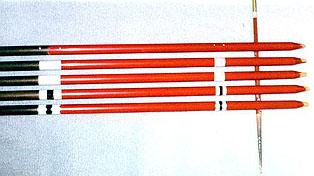
CRESTING - PART II
Now that you have all of the equipment that you need, you're
ready to start to crest your arrows. My first bit of advice
is try not to get into a big hurry. It seems that every time
I get in a hurry I mess something up.
1) Prepare the shafts: Make sure that your shafts are fairly
straight. For a reference on how to straighten wood shafts go
to that section and refresh your memory. The shafts don't have
to be perfect, but they do need to be reasonably straight.
It is difficult to get uniform cresting lines on crooked shafts.
I crest after I have applied 2 coats of whatever finish that
I am using. After each coat of clear finish has thoroughly
dried, rub until smooth with #0000 steel wool.
2) Lay out the pattern: It is a good idea to draw on an
index card the cresting pattern that you want to use. Use this
pattern to make your first shaft. After that you can either
transfer that pattern to each individual shaft, or fix the pattern
to your cresting machine to use as an indicator for each successive
shaft.
3) Start with the base color: If you are going to be using
bright or metallic colors, it is usually best to lay down a base
of white first and then apply the colors over the white. You
get a lot better coverage this way without having to use a lot
of coats of paint. Put this base color on each of your shafts
and let it dry thoroughly. In all of your cresting use several
thin coats rather than trying to put on one thick coat. Also,
clean your paint brush often. I will clean my brush between
each arrow for every color that I am using. Paint consistency
is important. If the paint is too thin you will have trouble
getting any sort of opaque coverage. If the paint is too thick,
then you will have trouble getting a smooth finish. Experiment
a little on an old shaft before you start. Another important
thing is how much paint is loaded on your brush. You want enough
to get good coverage, but not so much that it is difficult to
control how much you're putting on. Also, don't leave the brush
on the shaft very long, particularly with fast-drying paints.
If you do then the paint will start to dry and you will get
a very rough finish.
4) Add other colors: After you have the base coat, start
with the wider bands of whatever colors you have chosen. I like
to work from the thick bands down to the narrow bands. Again,
do one color at a time, take your time and let each arrow dry
thoroughly before you put on a different color. (See photo 1
showing each successive phase)
5) Add thin line to separate colors. I like to put a thin
line of silver between other color bands. This really adds a
striking look to your cresting. For this, you will need a very
small brush with a very fine point. This is something that
just takes practice, but once you get the hang of it, it really
goes pretty fast. (See photo 2).

6) Let the shafts dry thoroughly. If you want to apply a
clear dip over the entire shaft, then let them dry for a day
or two before you do dip to prevent the cresting paint from smearing.
7) Using markers instead of paint and brushes - Some of
the paint markers on the market work very well. The only difficulty
that I have found is that they tend to run if you try to dip
a clear coat over the entire crest. One way to avoid this running
is to apply a clear coat spray over the crest rather than dipping.
The markers that I have used most are the Opaque Paint Markers
made by Deco Color. You can buy them at a hobby supply or art
supply store. Buy the markers with the "extra fine"
tip. The advantage of the markers is that there is no brush,
no brush cleaning and you get a very uniform line. There is
no clean-up as you just put the cap back on the marker. You
can also use them to add other little details like drawing a
set of deer tracks on your arrow, putting on your name or initials,
or any other thing that your creative mind can think of.

